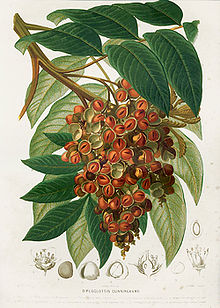- Diploglottis
-
Diploglottis 
Diploglottis cunninghamii Scientific classification Kingdom: Plantae (unranked): Angiosperms (unranked): Eudicots (unranked): Rosids Order: Sapindales Family: Sapindaceae Genus: Diploglottis
F. MuellSpecies See text
Diploglottis is a genus of 10 species of tree in the soapberry family Sapindaceae. Eight of the species are found in eastern Australia, primarily as a rainforest tree and the other two are in eastern Malesia and New Caledonia. Some species are known as native tamarind or small-leaved tamarind; they have no direct relationship with the true tamarind.
They are distinguished by their deep, green leaflets which are arranged oppositely, and the leaflets form paripinnate leaves.
One Australian species, D. cunninghamii is grown as a street tree in the Northern Rivers area of New South Wales, principally Lismore and is known locally as the native tamarind.
Another endemic Australian species is D. campbellii, also known as the small-leaved tamarind, is rare and threatened and is restriced to a small number of sites each with a maximum of three trees per site. There are a total of 42 known mature wild trees in south-east Queensland and north-eastern New South Wales. However, the tree, as a seedling, is readily available from nurseries in the Northern Rivers area of New South Wales, and in south-eastern Queensland. The small-leaved tamarind grows to 30 metres and has a compact canopy, making it good to use as a screening tree. It has small three-lobed fruit capsules. The fruit is edible and is commercially produced as bushfood. It is red when ripe and can be made into jam.
Other species in this genus include
- Diploglottis australis - considered a synonym of D. cunninghamii
- D. berniana
- D. bracteata
- D. campbellii - Small-leaved tamarind
- D. cunninghamiana
- D. cunninghamii - Native tamarind
- D. cunninghamii var. diphyllostegia
- D. diphyllostegia
- D. harpullioides
- D. macrantha
- D. smithii
Diploglottis species are used as food plants by the hepialid moths Aenetus ramsayi and Aenetus scotti.
Categories:
Wikimedia Foundation. 2010.

